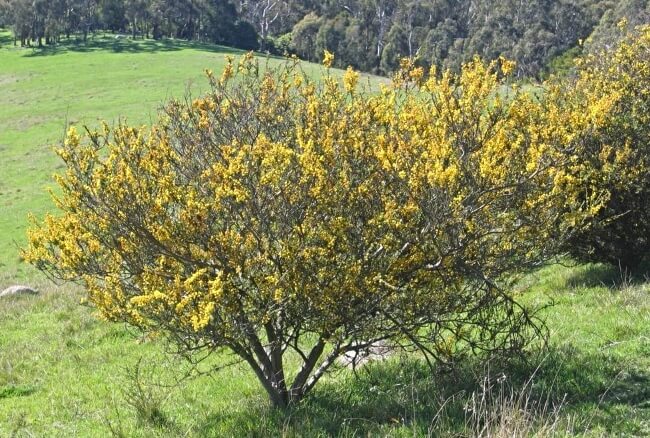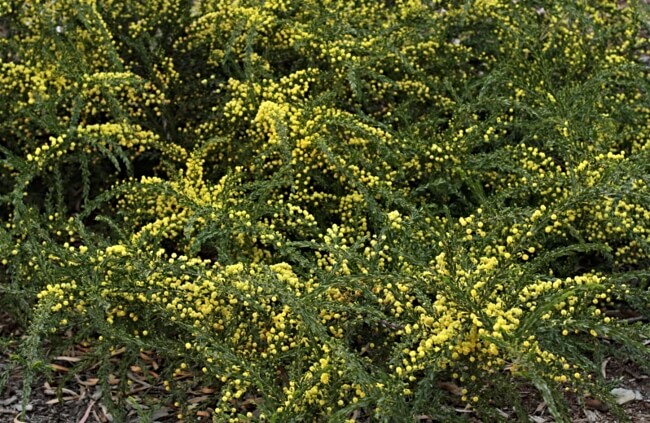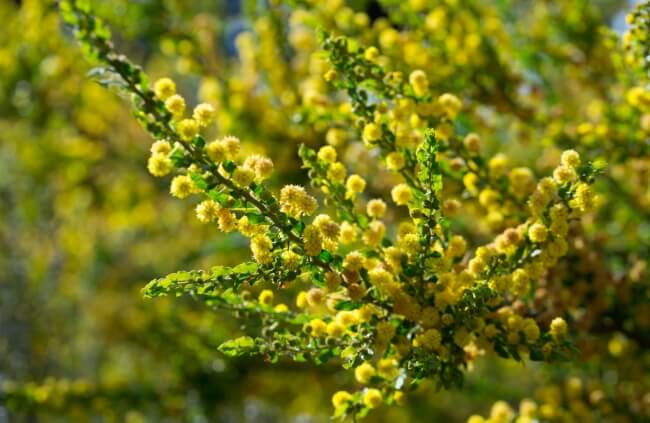Acacia paradoxa, commonly known as Kangaroo thorn, is one of my favourite native plants. It’s got a rugged brilliance and simplicity that helps every space it's growing become more natural in an instant. Its pale, creamy yellow flowers are elegantly simple, but pair up with fascinating structures in the form of intense spikes.
The tightly packed foliage gives the plant a wiry, matted look, but also offers a great native alternative to the common clipped hedging plants thanks to its predictable response to pruning.
In Tasmania, Western Australia and a few small pockets of the Northern Territory, it has naturalised and should be considered a weed. But for most Australian gardeners around the southeast (apart from Tasmania), we’ll share how to grow and care for this inspiring native shrub.
More...

Source: Yarra Ranges Council
Family: | Fabaceae |
|---|---|
Genus: | Acacia |
Species: | A. paradoxa |
Common names: | Kangaroo Thorn, Kangaroo Acacia, Prickly Wattle, Hedge Wattle |
Origin: | Australian native |
Location: | Outdoor |
Type: | Shrub or small tree |
Growth: | 4m tall and wide |
Sun requirements: | Full sun |
Foliage colour: | Glaucous, dull-green |
Flower colour: | Yellow |
Flowering: | August to November |
Edible parts: | Edible flowers and seeds |
Maintenance level: | Low |
Poisonous for pets: | Not toxic to pets |
What is Acacia paradoxa?
Acacia paradoxa is a small tree or shrub depending on its growth. Single-stemmed specimens can reach 4m tall, but most are restricted to 1.5-2m tall with regular pruning. Its deep green leaves and creamy yellow flowers contrast perfectly with each other in spring, adding interest, texture and a unique structure.
That structure lends itself perfectly to hedging, hence its common name, hedge wattle. The most common use all over the world is as a hedge, and it is not nearly as voraciously self-seeding as some other species, so is generally manageable in most gardens.
There are some warnings of its invasiveness outside of southeastern Australia, and it should not be introduced to Tasmania or Western Australia, where there are programmes to control and reduce its spread, to avoid harming native habitats.
Kangaroo Thorn’s Natural Habitat
Acacia paradoxa has a wide-ranging and varied native habitat, from woodland edges to open grassland, or free-draining hillsides and coastal sands. It is very easy going about its growing conditions, provided it has plenty of sun and minimal competition.
Its short stature and dense growth mean it quickly regenerates broken branches, building a dense shrubby texture in just a few years. For that reason, most of the wild specimens are shrubs, rather than trees.
Identifying Acacia paradoxa
Foliage is small and tight to the stem, growing alternately up the stem. At the foot of each leaf, a sharp spike grows at 90 degrees to the stem. From the same point, in spring most years, two flowers will emerge from the base of the leaf and thorn.
These later become elongated seed pods, that remain tight to the stem, growing away from the centre of the plant. This gives the overall appearance of a thick, needle-covered tree or shrub from a distance.
Up close, they are remarkably simple to identify compared to other acacias with longer leaves and looser growth.
Acacia paradoxa Control Outside of Southeastern Australia
Before talking about how to grow Acacia paradoxa, I want to share some important notes about its control. It is not a weed in most of the country, but it is a cause for concern in Tasmania and southern Western Australia, where it competes with other species, and outcompetes other genera that grow in similar conditions thanks to its habit of creating dense ground cover.
Kangaroo thorn self-seeds easily in most conditions, but seedlings can be removed easily before they are established to limit further spread.


Get Your Free Guide:
Master Growing Australian Natives eBook
A Must Have Complete Guide for Every Australian Garden
Get Your Free Guide:
Master Growing Australian Natives eBook
A Must Have Complete Guide for Every Australian Garden
Mature trees in environments where they are of concern can be removed by cutting the stump to the ground and digging out all possible roots. However, this can leave a potentially viable taproot in place.
Remove as much tap root as possible, or paint root-killing chemicals on to the stump as a last resort.
How to Grow Acacia paradoxa
Acacia paradoxa has preferences, but it is always well worth noting that it can and will grow just about anywhere. Propagation is fairly straightforward, but harder than for other acacias, and while it doesn’t suffer from pests in excess, there are some significant pests and persistent fungal problems that can cause problems from Acacia paradoxa.
I’ve shared, in simple terms, some of the best ways to grow a healthy hedge wattle, from planting, sowing and pruning, to harvesting the edible seeds. Everything you need to know about Acacia wattle is included in the grow guide below.

Source: Westgate Biodiversity
How to Plant Acacia paradoxa
Acacia paradoxa can develop into a 4m by 4m shrub, or a 4m tall tree, so needs plenty of space to develop. But, because of its dense branches and wiry stems, there are a few alternative options for growing these intriguing plants.
The most common is as a hedge, where the long, tightly held leaves and spiny stems create a dense formal hedge very quickly, and one that can, with good care, reach 4m tall – therefore creating an excellent privacy screen.
To plant as a hedge, space each plant at 1m intervals, allowing space to grow, root and knit into each other well.
To plant Acacia paradoxa as a single specimen plant, make sure it is planted at least 4m from any solid structures to avoid root damage, and then leave it to do its thing. Both options offer wonderful structure and dense coverage.
Note: Acacia paradoxa has deep and wide roots that actively break up poor soils. To make sure the roots grow out quickly rather than spiralling around, follow the conditions guide below to prepare the ground, then dig a large square hole to encourage roots to grow outwards.
Ideal Conditions for Growing Acacia paradoxa
Having decided how to grow your kangaroo thorn, you need to decide on where. In nature, they can be grown in a wide range of conditions, and on varying soil types. Below, we’ll look at their preference, but with an important caveat: you can be flexible with all of it… they’re tough plants.
Soil & Drainage
Ideal conditions for Kangaroo thorn (Acacia paradoxa) are free-draining, fairly poor soil. It can be shallow or deep soil, provided there are no standing water or drainage issues within the first 1m of soil.
They can cope with acidic, natural or slightly alkaline soils, but very alkaline soils (pH of 8 or more) will need amending before planting.
Light & Temperature
Like all Acacia species, kangaroo thorns prefer to be in full sun for at least eight hours per day. That basically means not to plant it in the southern shade of a house, or larger trees. Shade from the east or west will usually still allow sufficient sunlight for most of the day.
They are hardy trees and can withstand drought and frosts.
Shelter
No shelter is necessary. Acacia paradoxa copes brilliantly with coastal and salty air, with foliage adapted to deal with being splashed and sprayed with seawater.
Trees grown as a single stem can be brittle against strong winds but will regrow from the trunk, while shrub forms regularly lose branches (birds snap them off to nest with, and others snap off in high winds). However, for shrub forms, those lost branches actually help to thicken out the canopy, building a denser domed shrub in the long run.
How to Propagate Acacia paradoxa
Propagating Acacia paradoxa doesn’t require any special equipment, just some good old-fashioned compost and something to keep it in.
Whether it is growing from seed or cuttings, there are things you can do to boost your chances, but as it’s a member of the pea family, they are optional rather than essential and merely aid in rooting and germination, rather than being essential to it.
Acacia paradoxa Propagation from Seeds
Germination is faster and more reliable if you scarify kangaroo thorn before sowing it. The seed casings are tough, and getting water in can take time, meaning you’ll have to keep your compost moist, risking fungal issues before seeds even germinate.
To boost germination success, either scarify your seeds by rubbing gently on coarse sandpaper or use the method we find most reliable – just soak them in warm water.
Fill a clear glass with warm tap water, and pop your acacia seeds straight in. After 24 hours, you might even see the seeds starting to germinate. After 24 hours, drain the seeds, and sow them directly into a fine, well-drained, seed compost.
Germination is usually pretty quick after this, and plants can be pricked out when they’re about 5cm tall into individual pots.
Propagating Acacia paradoxa from Cuttings
Semi-ripe cuttings, taken in late summer, and stored somewhere cool but bright, take about a month to root. They will need a quick dip in rooting hormone before planting the cuttings to help things along, but provided you strip down most of the leaves, you will have a healthy new plant in no time.
Method:
- Fill a pot with equal parts compost and perlite.
- Using sharp, clean secateurs, cut a 5-10cm section of Acacia paradoxa (this should include about 6 nodes).
- Stirp back all the leaves and spines other than the top pair.
- Dip the cut end in rooting hormone, and insert it straight into the potting mix.
- Water it well then allow it to drain, before placing it somewhere cool, and bright, but away from direct sunlight and ideally reasonably humid.
- Roots should appear after two weeks, and new growth should be visible after a month.
Caring for Kangaroo Thorn
Acacia paradoxa is relatively long-lived for an Acacia species. The genus typically has a lifespan of 20 years in cultivated settings. Perhaps due to its shrubby nature, and resilience to snapping, its thin dry stems rarely get infected, and provided it isn’t at risk of fire, there’s no reason you won’t have this plant forever.
Caring for your hedge wattle is, therefore, incredibly important, but also incredibly simple.
There is no need to mulch or feed Acacia paradoxa, and watering after its first summer is not advised. The main things to keep an eye on are shape, structure and size.

Source: Lucidcentral
Pruning Acacia paradoxa
For mature Acacia paradoxa, grown as trees or large shrubs, there is no need to prune them. In the unlikely case that you notice leaf or stem infections, cut out the damaged parts of the plant to the next healthy point, but otherwise pruning is more likely to cause infection than stop it.
However, for kangaroo thorns to be grown as a hedge, you’ll need to prune twice a year. Once in early summer (or straight after flowering), and once again in late autumn to maintain the shape and encourage tighter growth.
Repotting Acacia paradoxa
It is also very possible to grow these plants in pots, particularly when pruned tightly to celebrate their flower colour and leave texture. The only additional responsibility for gardeners is to repot Acacia paradoxa every three to four years, to prevent roots from damaging the container and becoming rootbound.
Despite them needing free-draining conditions, it’s also worth watering potted Acacia paradoxa once a month in summer just to take the edge of any potential heat waves as pot-grown plants dry out significantly quicker than those in the ground.
Harvesting & Storing Acacia paradoxa
Each year, from January through to early April, wattle seed becomes one of the most readily available bush tucker foods. Hedge wattle (Acacia paradoxa) is one of the most useful garden plants for this purpose because it rarely gets unmanageably tall.
That means it's harvestable without a ladder (important given the spiky nature of these shrubs).
Once the flowers have been pollinated and faded, the seed pods develop quite slowly and are ready to harvest when they turn brown. The seeds inside will be firm and quite tough-skinned, but not completely dry.
You can leave them on the plant to dry out entirely, or harvest them and dry them on a windowsill, or in an oven.
Once dry they can be stored as whole seeds in an air-tight, dry container, in a dark cupboard, or ground up and stored in similar conditions. The seeds and ground seeds can be used to flavour foods or as a caffeine-free coffee substitute.
Common Hedge Wattle Pests and Diseases
Pests and diseases aren’t of any major concern with this species, but there are cases from elsewhere in the world where Acacia rust has been deliberately introduced to control the spread of some species as invasive weeds.
Weevils, leaf beetles and borers are the most concerning pests found on Acacia paradoxa. They feed on foliage and tunnel into stems and leaves, causing lasting damage, but also creating avenues for infection to enter leaves.
Most can be tolerated and will be managed by birds and other insect predators. There are a handful of problematic Acacia diseases that do affect Acacia paradoxa, particularly in colder parts of the country than its native southern Western Australia.
The most common are typical leaf funguses like Xylella and Verticillium, but they are very rarely significant enough to need any treatment. One fungal problem that does, however, is Acacia rust.
Acacia rust
Acacia rust is a particularly unsettling fungal infection that can sadly cause the death of Acacia paradoxa, or any other Acacia it infects. However, if caught early, it is very possible to resolve and prevent its spread.
Simply cut out any growth with the swollen orange galls present, and take an additional section of branch back to be extra cautious. Burn the affected materials, and dispose of the ashes.
Kangaroo Acacia Frequently Asked Questions

What is Acacia paradoxa used for?
Acacia paradoxa has countless garden uses, from screening to punctuation designs with its solid form, but it is also a botanically useful tool for soil retention, helping to stabilise loose slopes and provide shelter from harsh coastal winds.
Is Acacia paradoxa good for wildlife?
Acacia paradoxa is an exceptionally useful plant for wildlife. It grows well in garden settings, and its dense bushy canopy provides a safe haven for small birds, as well as a rich source of nectar for the birds and pollinating insects alike.
Is Acacia paradoxa a good hedge plant?
Acacia paradoxa is a great hedge plant, but probably not the best choice for gardens with small children as the spiky stems are particularly unforgiving. There are other, less aggressively spiked acacias for similar purposes.
What is the lifespan of Acacia paradoxa?
There is no set or expected lifespan for Acacia paradoxa. It is a long-lived Acacia species, which is distinct and unusual for the genus. Thanks to its thorns, it is rarely eaten by grazing mammals, and its ability to regenerate from snapped wood is impressive. Fire will kill it, but is unlikely in most gardens.
Why is my Acacia paradoxa dying?
The most common causes of dying, wilting, or sad-looking Acacia paradoxa are exposure to late or extended frosts or prolonged wet weather over winter. They do not do well in poorly drained conditions, and can quickly show signs of deterioration.
Why is it called Acacia paradoxa?
Acacia paradoxa gets its scientific species name from the paradox posed by its beautiful, tender and delicate flowers, paired with the aggressive throws growing for the same node. Unlike most thorny plants, these thorns are growing from the same cells as the flowers – hence, paradox.
Is Acacia paradoxa an evergreen?
Acacia paradoxa is an evergreen shrub, holding its leaves all year round. Obviously, that adds to its appeal as a hedge plant (common name: hedge wattle), but it also adds to its usefulness as a wildlife habitat, providing cover for birds for twelve months of the year.
Is Acacia paradoxa toxic to dogs and cats?
Acacia paradoxa is not specifically toxic to dogs or cats, and the thorns would usually stop them from eating it anyway.
Embrace the Unique Charm of Acacia paradoxa in Your Garden
Of all of the Acacia we’ve covered on Aussie Green Thumb over the years, there aren’t any that are genuinely interchangeable with Acacia paradoxa. The kangaroo thorn, hedge wattle, prickly wattle (whatever you want to call it) really is quite unique.
For anybody considering it for their garden, it is definitely worth a go, but do keep in mind that it can potentially become invasive outside of its native range.
If you’re lucky enough to live near Victoria or the wider southeast, there just isn’t anything else that’s going to give you this same level of density and structural form from a native perspective.
Growing your own Acacia paradoxa is worth the effort, and incredibly rewarding, so grab a spade and plant one.
Published on October 12, 2023 by Nathan Schwartz
Last Updated on April 15, 2025




